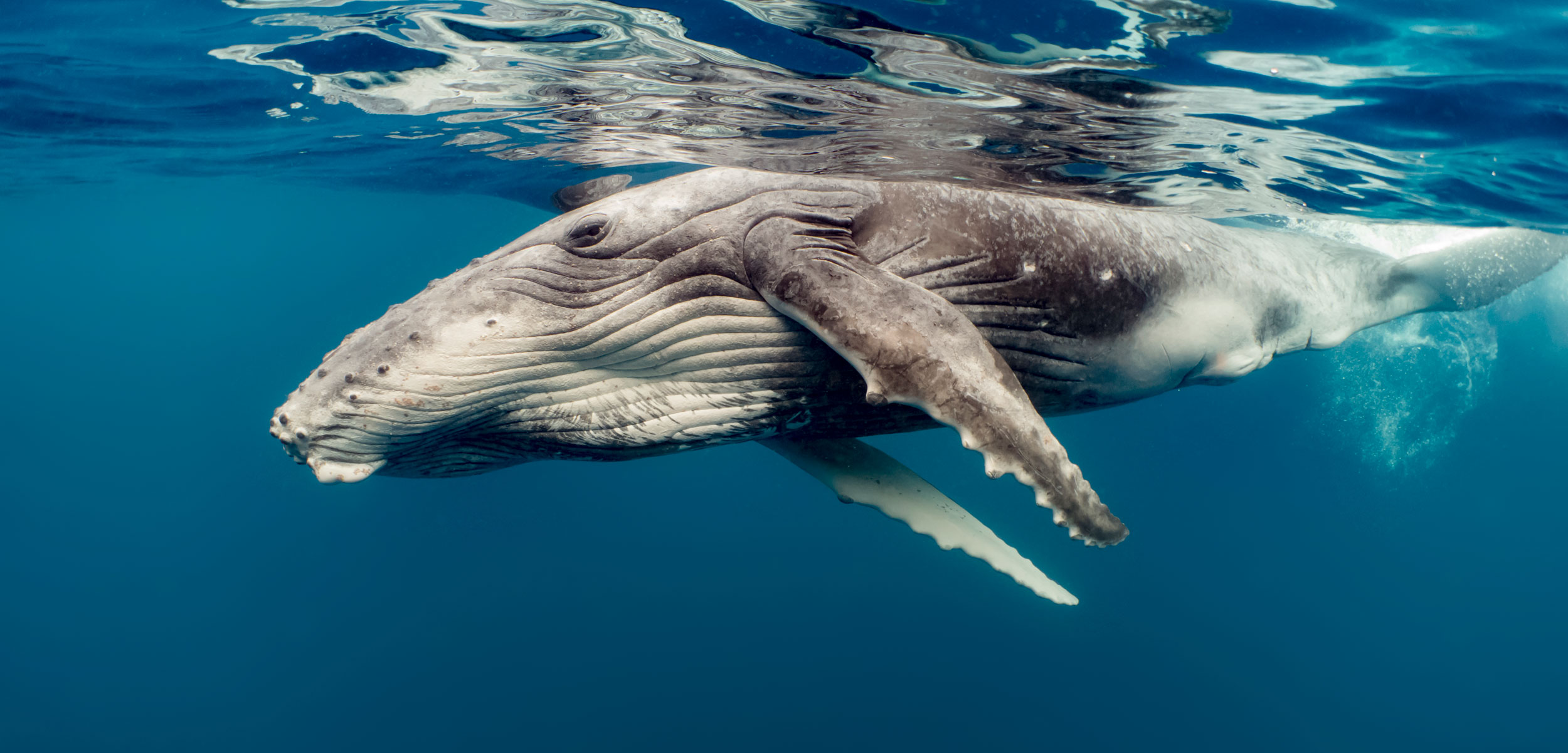What Were Two Humpback Whales Doing with a Dead Gray Whale Calf?
Researchers are stumped by the rare case of interspecies interaction.
Article body copy
Dense early-morning fog hovers above Monterey Bay, California, as wildlife photographer Jodi Frediani steps aboard the Point Sur Clipper, a sturdy two-tiered whale watching boat. It’s the middle of April, high season for whales in Monterey Bay, and she’s come to photograph them.
Cruising through the bay, the clipper tails a pod of killer whales. But the excursion is soon interrupted by a crackle over the radio and a call from another whale watching boat. Humpback whales have been spotted nearby and they are behaving oddly. The ship changes course.
As they approach, Frediani sees two massive humpback whales circling the half-eaten remains of a gray whale calf that was killed by killer whales the day before. As Frediani watches, the humpbacks move in and touch the half-eaten carcass. They bellow trumpet-like sounds. They’re excited, or perhaps agitated.
Frediani starts photographing and taking detailed mental notes, which she later writes down, hoping to capture what she suspects is unprecedented humpback whale behavior.
Scientists have differing views about the event. Some say the humpbacks were showing signs of mourning; others say the whales were simply curious or confused. Still others suggest the humpbacks’ behavior was a sign of the species’ history of protective altruism.
The one thing scientists can agree on is that the event truly is fascinating. The scientists’ conflicting interpretations are a reminder of how little we know about humpback whales’ psychology.
“We are always open to documenting rare behaviors because they can shed light on cetacean interactions with their own and other species,” says Robert Pitman, a humpback whale expert with the US National Oceanic and Atmospheric Administration.
Humpbacks are gaining a reputation for their protective behavior. Previously, they’ve been seen guarding humpback whale calves from killer whale attacks. They’ve also safeguarded juvenile gray whales, seals, sunfish, and other marine species from these crafty predators. When killer whales pursue prey, humpbacks will often vocalize or mob the predators. Even when killer whales make a successful kill, humpbacks have been known to chase them away or block them from consuming the carcass.
Some scientists think adult humpbacks’ behavior toward killer whales may be motivated by their own experiences being attacked as juveniles. But Pitman thinks there may be another, somewhat less flattering explanation for humpbacks’ adopted role of interspecies bodyguards.
“Evolutionarily, it makes sense to prevent killer whales from attacking their own calves,” Pitman says. But humpback whales aren’t particularly smart, he adds—they may be mistaking other animals for juveniles of their own kind.
“So maybe they just try to prevent killer whales from attacking anything and try to assist other calf-sized animals if they need help,” says Pitman. “Adult humpbacks are not vulnerable to killer whale attacks, so the cost is minimal.”
In the case of the gray whale calf observed by Frediani, Pitman suggests the humpbacks may not have known the calf was dead and thought it could still be attacked by the killer whales.
The unusual sighting fits into the larger scientific effort to understand how cetaceans such as dolphins and whales interact with their dead.
Pitman recently worked with dolphin expert Giovanni Bearzi and several other scientists to review 78 known cases of animals interacting with their dead across 20 cetacean species. Observed behaviors included carrying or touching the deceased, and possibly even attempts to revive a dead animal by pushing it up to the water’s surface. Adult dolphins are the most likely to exhibit these kinds of behaviors, usually with juveniles of their own species.
Cetaceans’ intense and sometimes long-lasting attachments to their dead could be interpreted as grief or mourning, the researchers suggest. Yet the review offers no clear interpretation of the behavior observed in Monterey Bay. Interspecies interactions have not been seen often enough to have been properly studied, Pitman says.
To truly understand what happened, Bearzi says, would require rigorous documentation including high-resolution photos and steady, sharp videos shot above and below water, as well as records of species and approximate ages of the animals involved. Without more solid evidence, he says, Frediani’s account can be interpreted only as “humpbacks inspecting a dead gray whale calf.”
But with more observations and detailed documentation, perhaps scientists will one day understand the reasons behind these interactions.
“Most of us may have personal opinions,” Bearzi says. “But we largely do not know what is really going on in cetacean brains when they attend to dead individuals. We must acknowledge our present ignorance and perhaps keep a door open to the unexpected.”

